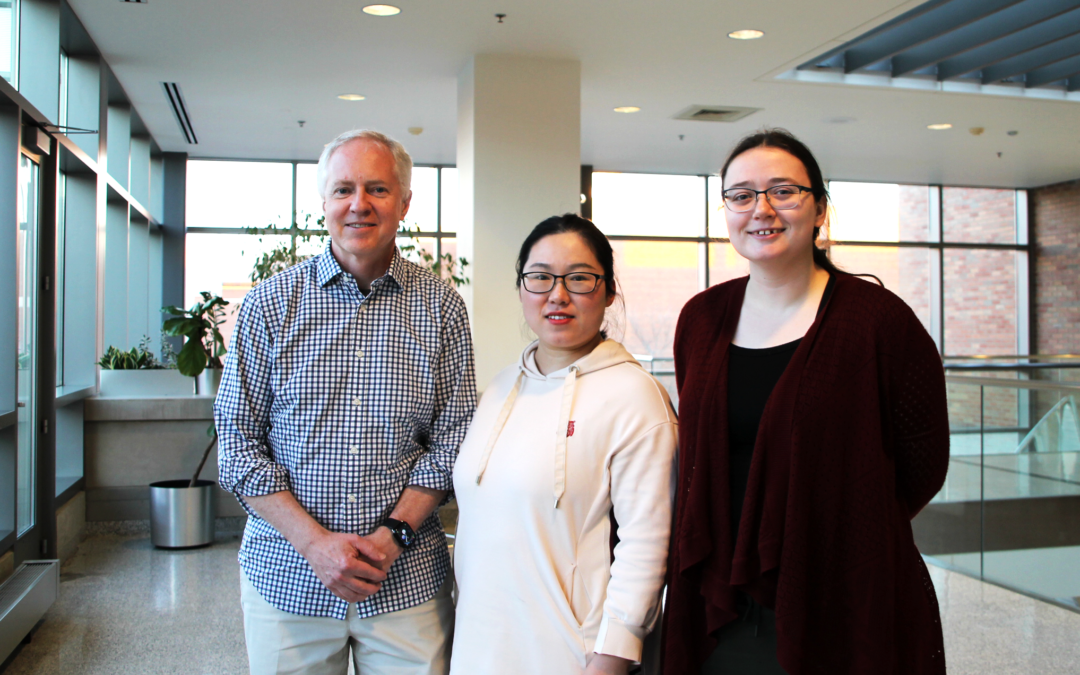Researchers set sights on prostate cancer with new, rapid biomarker detection method
Feb 6, 2023 | Cancer Center News
Cancer Center at Illinois program leader Brian Cunningham is joined by research project members, from the left, Xiaojing Wang and Skye Shepherd, who were co-first authors on the teams’ recently published research. Team members not pictured include: Nantao Li, Congnyu Che, Tingjie Song, Yanyu Xiong, Isabella Rose Palm, Bin Zhao, Manish Kohli, Utkan Demirci, Yi Lu.
Photo by Dani Ciesielski
Urbana, Ill. – The pivotal role of microRNA in diagnosing and monitoring cancer is well known by today’s researchers. “There have been a lot of studies in recent years linking the presence and concentration of specific microRNA sequences to clinical outcomes for people with advanced prostate cancer,” said Brian Cunningham, program leader at the Cancer Center at Illinois and professor of electrical and computer engineering.
Yet, the methods for detecting this pivotal biomarker in cancer diagnostics remain cumbersome, costly, and inaccessible to many. This stands to change with a novel method recently designed by Cancer Center at Illinois researchers.
In collaboration with Huntsman Cancer Institute and Stanford University, Cunningham’s team has been leading a project to improve upon microRNA detection methods for prostate cancer. In a paper published in the journal Angewandte Chemie, the team presents their new method of microRNA detection and quantification that dramatically improves upon current methodology.
“Our method is very simple. You don’t need temperature controls and enzymes, it can be used not only for microRNA detection, but also for other small RNA and DNA detection, the equipment is very inexpensive, and the reaction time is only 10 minutes,” first author Xiaojing Wang said.
Yes, the team’s new method provides results in just ten minutes – compared to hours for traditional PCR testing – and provides a promising new pathway toward accessible point-of-care scenarios for cancer patients.
Thanks to COVID-19 testing, PCR is now well known, but the PCR method is not adequate for cancer diagnostics in the mind of Cunningham’s lab whose goal is to develop new methods – methods that are faster, more sensitive, less expensive, and easier to perform.
“The main issue for PCR is that you need trained personnel in centralized laboratories. So, if you are at a university that is fine, but if you’re in a place with fewer resources, this improved point-of-care method we’ve developed is more efficient and easier to implement,” says Skye Shepherd, a graduate student in bioengineering and co-first author on the group’s published research. “Being able to very quickly detect microRNA is vital for creating equitable healthcare and access to these sorts of tests, so that is a motivation that helps us create these rapid, room temperature tests.”
This motivation provided the context in which Shepherd and Wang produced the unique method they’ve named Target Recycling Amplification Process, or TRAP. This method links one gold nanoparticle to one microRNA fragment, and uses a visualization method also created by the team – Photonic Resonator Absorption Microscopy (PRAM) – to detect microRNAs as they are repeatedly released and redetected in a recycling process.
PRAM allows researchers to see the gold nanoparticle tags on a photonic crystal biosensor surface. Altogether, the new amplification method in tandem with PRAM allows researchers to effectively detect very small traces of microRNA molecules in a swift manner – which has the potential to greatly improve the efficacy and accessibility of cancer diagnostics and treatment monitoring.
Next steps for the team’s project include clinical collaborations where blood samples from 100 prostate cancer patients will be tested using TRAP to monitor prostate cancer progression and evaluate treatment efficacy. Cunningham suggests the implications of the team’s new method may pave the way for improved diagnostics and treatment monitoring in other forms of cancer, nutrition, and maternal health.
Editor’s notes:
Brian Cunningham is a Cancer Center at Illinois (CCIL) program leader for the Cancer Measurement Technology and Data Science program, the Intel Alumni Endowed Chair of the Department of Electrical and Computer Engineering, a professor of bioengineering, and the Holonyak Micro and Nanotechnology Lab. Cunningham is also the the Director of the Center for Genomic Diagnostics theme at the Woese Institute for Genomic Biology.
To contact Brian Cunningham, email bcunning@illinois.edu
This work was supported by the National Institutes of Health (NIH), Carl R. Woese Institute for Genomic Biology, and Grainger College of Engineering.
The paper “A Target Recycling Amplification Process for the Digital Detection of Exosomal MicroRNAs through Photonic Resonator Absorption Microscopy” is available online. DOI: 10.1002/anie.202217932
Written by the CCIL Communications Team